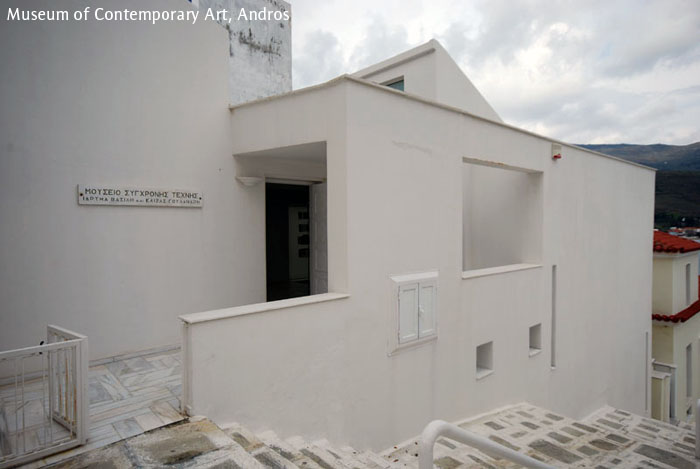Kyriakos Koutsomallis, Director of the Museum of Contemporary Art in the island of Andros, Basil and Elise Goulandris Foundation.
It was a pleasure to receive Father Stamatis Skliris’ invitation to visit him at his studio in Paris. Conversation with him is an intellectual stimulus. His figurative language is on a level with his cogent dialectic. It is dynamic and carefully structured, and it makes no secret of the kind of relationship he wishes to suggest by the natural world he represents in his painting.
The topicality and the immediacy of the problems he considers and the dynamics of the interpretative approach in his views of the world leave no room for pretentious, conventional schemata, while at the same time they signal the presence of a gifted, creative artist who desires to experience to the full the times in which he lives and to be in the van of them.
Father Stamatis’ figurative language is not the language employed to illustrate outward appearances, but a conscious intellectual endeavor to disco-ver and define those more essential characteristics that assure authenticity and, by extension, self-sufficiency and autonomy to a work of art.
His painting rests on the fundamental aesthetic axioms of Byzantine art, but is not restricted to its exclusive and formalistic prototypes.
As a religious artist he has recourse to the iconographic teachings of Panselinos and Theophanes—the leading exponents of the two outstanding schools of religious painting—and he studies the works of the Asia Minor painter Kontoglou, though he stops short of following their unwavering orientation upon Byzantium, let alone the broadsides and abuse they direct against Western art. Without severing his connection with tradition he introduces into his plastic compositions features that tend to obliterate or obscure the dividing-line between religious and secular art. His persistent objective is the erasure of this distinction and the adoption of a unique, inflexible, and uniform iconographic vision of things in which the sacred coexists with and is not separated from the mundane. Father Stamatis wishes himself a painter of his time, capable of being freely self-motivated and employing the means available to him and his day. Profoundly convinced that Byzantine art is in a position to advance important reinvigorating solutions not only for modern Greek art but also for contemporary Western art in general, he would like his painting to serve as a bridge between our own Greek tradition and European art today.
Father Stamatis makes a masterful case for his Orthodoxy using arguments of the present day that shun all embellishment. The theoretical basis of his painting, centered largely upon man, is the existential anxiety experienced by his fellow human beings. In the course of a more interior but obvious paradoxical struggle that denies his apparent external calm, he transcribes enduring figurative archetypes in contemporary terms beneath a lens that magnifies modern man’s anxiety. His conducive aim being the investigation of the essence and truth of life as lived by sorely-tried mankind, his art, like that of Giacometti, whom he admires and studies, and of other expressionists, becomes a never-ending quest, a quest in constant crisis, dispute, and doubt.
He idealizes both his religious painting and his byzantinizing portraiture and presents figures in an abstract and, if possible, dematerialized form. His figures include Hellenistic male ones, marginal characters that function as symbols of isolation, and female figures at times startled and expressing what seems like passive acceptance of violence, for they are incapable of avoiding it, and at others a childlike wonderment and a questioning look, for they are incapable of understanding it.
Each figure is treated as having a notional value and so becomes the medium of a message or the witness of a Credo. The rudimentary quality with which he invests the figures in the series “The primitives” is a typical example. Similarly characteristic is the expression he imparts to his painting of “Prophet Elijah”. Instead of a calm and radiant look, the reward of final justification, his face bears all the signs of the attrition suffered in the course of the struggles he has undergone during his years on earth. The path of destruction and existential tragedy leads to immortality.
Overstepping the conventions of Byzantine art, Father Stamatis sets himself the original task of redefining things on a different basis and of establishing a different relationship between space and the object, but invariably in conjunction with current trends marked by the stylistic idiosyncrasies and plastic experiments of painting this century. His attempt to combine traditional elements with the mannerisms of contemporary painting, especially impressionism, is another characteristic of his work and is most evident in whatever has to do with the introduction of light into his works. In his painting, light ceases to be central and shadow to be peripheral. As in the prototype of pointillism, his brushwork is a jab, producing a series of small blobs of complementary colors.
In both his life and his art Father Stamatis Skliris knows how to capture the pulse of life itself and how to retain its essence by discarding mere appearances. His painting presents a different view of things. His work, pensive, sensitive, and confident, interprets essential truths with originality and has both meaning and significance for whoever desires to follow him in this different approach.
From: Père Stamatis Skliris, Itinèraire Pictural, Edition Akritas, 1994

